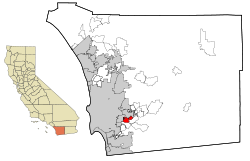2020
The 2020 United States census reported that the CDP had a population of 19,576. The population density was 2,857.4 inhabitants per square mile (1,103.2/km2). The racial makeup of the CDP was 65.0% White, 6.4% African American, 0.6% Native American, 4.0% Asian, 0.5% Pacific Islander, 8.2% from other races, and 15.3% from two or more races. Hispanic or Latino of any race were 23.2% of the population. [25]
The census reported that 99.1% of the population lived in households, 0.5% lived in non-institutionalized group quarters, and 0.4% were institutionalized. [25]
There were 7,108 households, out of which 29.2% included children under the age of 18, 57.4% were married-couple households, 5.8% were cohabiting couple households, 22.8% had a female householder with no partner present, and 14.1% had a male householder with no partner present. 18.9% of households were one person, and 10.7% were one person aged 65 or older. The average household size was 2.73. [25] There were 5,339 families (75.1% of all households). [26]
The age distribution was 19.7% under the age of 18, 8.1% aged 18 to 24, 21.9% aged 25 to 44, 27.9% aged 45 to 64, and 22.3% who were 65 years of age or older. The median age was 45.2 years. For every 100 females, there were 96.5 males. [25]
There were 7,370 housing units at an average density of 1,075.8 units per square mile (415.4 units/km2), of which 7,108 (96.4%) were occupied. Of these, 72.3% were owner-occupied, and 27.7% were occupied by renters. [25]
In 2023, the US Census Bureau estimated that the median household income was $123,037, and the per capita income was $58,567. About 2.5% of families and 4.7% of the population were below the poverty line. [27]
2010
The 2010 United States census [28] reported that Casa de Oro-Mount Helix had a population of 18,762. The population density was 2,737.8 inhabitants per square mile (1,057.1/km2). The racial makeup of Casa de Oro-Mount Helix was 13,375 (64.6%) White, 1,108 (5.9%) African American, 89 (0.5%) Native American, 593 (3.2%) Asian, 96 (0.5%) Pacific Islander, 996 (5.3%) from other races, and 999 (5.3%) from two or more races. Hispanic or Latino of any race were 4,815 persons (23.3%).
The Census reported that 18,563 people (98.9% of the population) lived in households, 110 (0.6%) lived in non-institutionalized group quarters, and 89 (0.5%) were institutionalized.
There were 6,943 households, out of which 2,179 (31.4%) had children under the age of 18 living in them, 4,036 (58.1%) were opposite-sex married couples living together, 745 (10.7%) had a female householder with no husband present, 360 (5.2%) had a male householder with no wife present. There were 365 (5.3%) unmarried opposite-sex partnerships, and 77 (1.1%) same-sex married couples or partnerships. 1,319 households (19.0%) were made up of individuals, and 617 (8.9%) had someone living alone who was 65 years of age or older. The average household size was 2.67. There were 5,141 families (74.0% of all households); the average family size was 3.02.
The population was spread out, with 3,945 people (21.0%) under the age of 18, 1,510 people (8.0%) aged 18 to 24, 3,807 people (20.3%) aged 25 to 44, 6,012 people (32.0%) aged 45 to 64, and 3,488 people (18.6%) who were 65 years of age or older. The median age was 45.4 years. For every 100 females, there were 95.8 males. For every 100 females age 18 and over, there were 93.6 males.
There were 7,249 housing units at an average density of 1,057.8 per square mile (408.4/km2), of which 5,018 (72.3%) were owner-occupied, and 1,925 (27.7%) were occupied by renters. The homeowner vacancy rate was 1.4%; the rental vacancy rate was 5.2%. 13,358 people (71.2% of the population) lived in owner-occupied housing units and 5,205 people (27.7%) lived in rental housing units.




